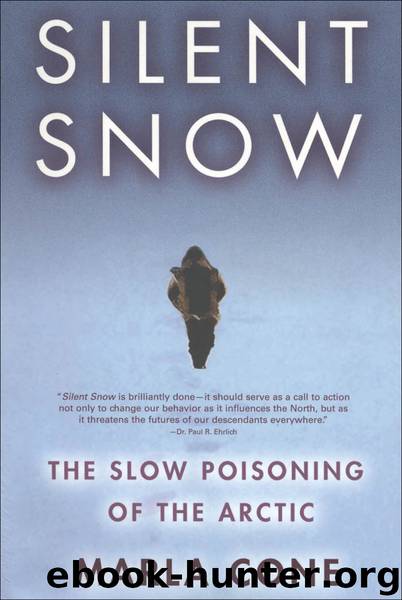Silent Snow by Marla Cone

Author:Marla Cone
Language: eng
Format: epub
Publisher: Grove Atlantic
Published: 2005-09-15T16:00:00+00:00
Balancing risks and benefits of food is not an easy task, which explains all this wavering and hand-wringing by Canadian health officials. Pierre Ayotte, a Canadian expert in human toxicology, says it is more of a judgment call than a science. “People talk a lot about risks and benefits. Easier said than done. It’s a little bit of an illusion to say we’ll have models to govern risks and benefits.” Much more is known about the benefits of Inuit foods than the risks. Ounce for ounce, few diets are as healthy when it comes to nutrients but as risky when it comes to contaminants. While oily fishes such as salmon and char contain lower doses of chemicals and relatively high doses of omega-3, even they cannot compare to the nutrients in whale and seal.
Arctic people have few healthy alternatives even if they do want to reduce their exposure to contaminants. Jose Kusugak, president of Inuit Tapiriit Kanatami, the organization representing Canadian Inuit, says he can buy “lame lettuce” and “really old oranges” and “dried-up apples” in his Nunavut village or he can eat fresh and nutritious beluga, walrus, fish, and caribou. “There is really no alternative,” he says. Dr. Harriet Kuhnlein, founding director of McGill University’s CINE (Centre for Indigenous Peoples’ Nutrition and Environment) in Montreal, reports that 30 percent of the dietary energy of Inuit living in villages comes from traditional foods, an amount that would be hard to replace with expensive imported foods. Fish and sea mammals are a daily part of their diet. Nevertheless, food is often scarce for the Inuit. A 2004 study by the Nunavik Regional Board of Health and Social Services in the village of Kuujjuaq showed that more than half the people there live in poverty and 68 percent were at risk of not getting enough food. For children, the figure rose to 74 percent. Low- and middle-income households experienced at least one episode a year when they didn’t have enough to eat.
“Unless nutrient supplements are routinely used, a decrease in use of sea mammal foods will place some individuals at health risk from nutrient deficiency,” says a CINE study, published in 2000, called “Assessment of Dietary Benefit/Risk in Inuit Communities.” In the survey of indigenous people, “respondents ranked traditional food as significantly more important than market food as healthy for children, healthy for pregnant and breastfeeding women, tasty and important to community life.”
As some Inuit move away from their traditional foods and eat a more American or European diet of processed items loaded with simple carbohydrates and sugar, rates of obesity, heart disease, and diabetes are climbing in some Arctic populations. On the days that the Inuit eat no traditional foods, they take in considerably less protein, iron, vitamin A, and omega-3 and more carbohydrates, saturated fats, and sugar. Not only are young people in some Arctic towns eating less nutritious foods, but they are also hunting less—so they are more sedentary. “We know people are eating less and less traditional food,”
Download
This site does not store any files on its server. We only index and link to content provided by other sites. Please contact the content providers to delete copyright contents if any and email us, we'll remove relevant links or contents immediately.
Man-made Catastrophes and Risk Information Concealment by Dmitry Chernov & Didier Sornette(5647)
The Revenge of Geography: What the Map Tells Us About Coming Conflicts and the Battle Against Fate by Kaplan Robert D(3961)
Zero Waste Home by Bea Johnson(3655)
In a Sunburned Country by Bill Bryson(3365)
COSMOS by Carl Sagan(3346)
Good by S. Walden(3345)
The Fate of Rome: Climate, Disease, and the End of an Empire (The Princeton History of the Ancient World) by Kyle Harper(2870)
Camino Island by John Grisham(2719)
A Wilder Time by William E. Glassley(2689)
Organic Mushroom Farming and Mycoremediation by Tradd Cotter(2565)
The Ogre by Doug Scott(2501)
Human Dynamics Research in Smart and Connected Communities by Shih-Lung Shaw & Daniel Sui(2431)
Energy Myths and Realities by Vaclav Smil(2380)
The Traveler's Gift by Andy Andrews(2299)
9781803241661-PYTHON FOR ARCGIS PRO by Unknown(2268)
Inside the Middle East by Avi Melamed(2230)
Birds of New Guinea by Pratt Thane K.; Beehler Bruce M.; Anderton John C(2175)
A History of Warfare by John Keegan(2104)
Ultimate Navigation Manual by Lyle Brotherton(2048)
